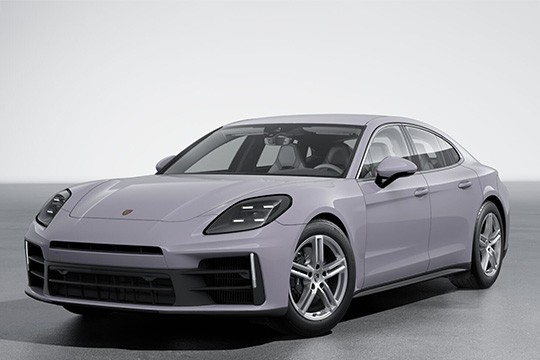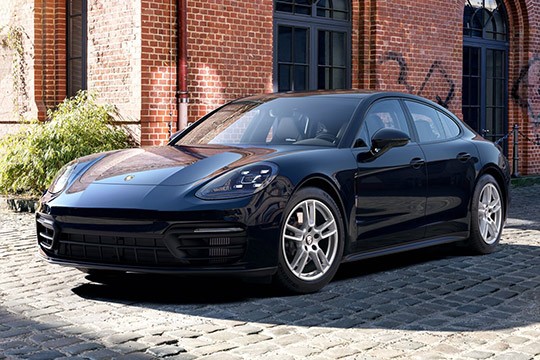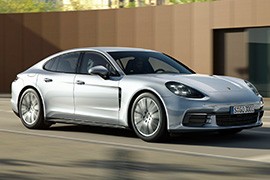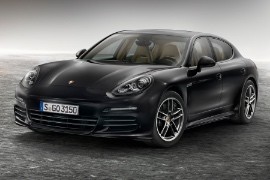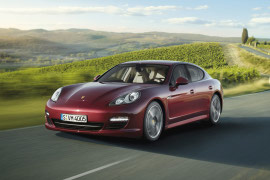PORSCHE Panamera Models/Series Timeline, Specifications & Photos
First production year: 2009
Engines: Gasoline
Porsche introduced the third generation of the Panamera in late 2023, and, at first sight, it was more of an evolution rather than a revolution, but the brand's fans didn't have to worry; the four-door Porsche sedan produced enough oomph to make them happy.
The first generation of this nameplate appeared on the market in 2009 and sent a huge shockwave to the market, but Porsche's stakeholders were happy. After the successful Cayenne, the Panamera came to fill the gap between the two-door sportscars and the carmaker's SUV lineup. Even though it wasn't the most beautiful car on the market, it was convincing, thanks to its drivetrain. In addition, the level of luxury and comfort was on par with the brand's status. But fast forward to 2023, and the German automaker had already reached the nameplate's third generation, and the changes compared with its predecessors were massive… but well hidden.
From the outside, the car sported a front fascia that clearly resembled the 911 lineup with its four LED blocks inside the headlights. Furthermore, the same signature light pattern was noticed on the Cayenne and other Porsche vehicles. But any vehicle fitted with an internal combustion engine needed a cooling area, and the automaker placed that in the lower side of the bumper. The lower grille was black and divided into three sections. In addition, two horizontal slats crossed the apron from side to side. But the car's overall look resembled the previous generation, just with different headlights and bumper.
The interior went through a major update. In front of the driver, the automaker installed a fully digital instrument cluster where the tachometer took center stage. However, the driver could re-arrange what they could see on that display. In addition, atop the center stack, Porsche installed a touchscreen for the infotainment system, while underneath it, on the center console, a touchscreen for the HVAC system. Like the Panamera's first generation, the 2024 model year came with four individual seats, with high-bolstered ones for the front occupants. Between those seated in the back, the automaker installed a storage area. Still, customers could get the vehicle with a five-seat option.
When Porsche made the first generation of the Panamera, it created a unique profile for the vehicle and kept it throughout the car's generations. As a result, it created a specific design language for this nameplate. The raked windshield and curved roofline ended into a sloped-down rear end that covered the trunk. Behind the front fenders, the automaker placed thin and tall extracting vents that reduced aerodynamic lift. Finally, at the back, the Panamera featured a long red LED stripe for the taillights with Porsche lettering underneath. As a signature design for this version, the automaker installed a set of side exhausts with a trapezoidal shape.
Under the hood, the Panamera featured a turbocharged 2.9-liter V6 that powered the rear wheels only via an eight-speed automatic transmission. However, the most significant difference compared with the previous Panamera was the enhanced adaptive suspension and the four-wheel steering capability. Furthermore, the car raised when it was stopped to ease ingress and egress.
In 2020, while the world was struggling with the COVID 19 pandemic, Porsche remained true to its promises and brought the facelifted version for the second generation of the Panamera.
The base model from the Panamera was a rear-wheel-drive luxury sport-sedan. It was the entry-level, but it wasn't a basic car. The facelifted version brought even more features than before, but it was still a rear-wheel-drive, twin-turbo V6 vehicle.
For the 2020 model, the Panamera featured a redesigned front fascia, with a different bumper and lower apron. The previously optional Sport Design front end was featured as standard on the facelifted version. In the back, the revamped light strip ran seamlessly over the trunk lid, with an adapted contour and new LED taillights were installed. The three-piece retractable wing was kept.
The interior of the 2020 Panamera featured the already known Porsche Communication Management infotainment system with a 12.3” touch-screen display mounted at the same level as the steering wheel, on top of the center stack. It featured the improved Voice Pilot online voice control and wireless Apple CarPlay. Porsche didn't say anything about the Android Auto connectivity.
Under the hood, the Porsche Panamera featured a twin-turbo V6 engine, good for 330 hp. It was carried-over from the non-facelifted version. The 7-speed PDK (dual-clutch) automatic transmission was fitted as standard. It was the only option available.
While the first generation of the 4-door Porsche suffered in the beginning for lots of criticism, its successor showed no mercy on the detractors.
The idea of a 4-door Porsche sedan wasn't new. There were some try-outs in the late '80s with the 989 concept-car that was based on a stretched platform of a 911. But the real deal was shown in 2009 with a front-engine and rear or all-wheel-drive. Its design was not that good, but the car's handling was convincing.
2016 started right with an already established name on the market and the look was way better. The rear end was looking sort of a 911, but better. The designers tried to build a short hood and moved a part of the engine under the windshield area. The headlights were very similar to those on the 911 and the car had great success.
Inside, the touch-screen mania caught well and some buttons from the center console and from the dashboard disappeared. A 12.3" touch-screen infotainment unit found its way onto the dashboard. It was nicely integrated but without an Android Auto connection. The Porsche marketing department said that its users are mostly iPhone users, so they matched it only with Apple CarPlay. The Android phone users had to download a special Porsche app that could work with the unit. The dashboard featured an analog tachometer in the middle, a tribute to the Porsche 356. On the sides, two 7" TFT screens could show various information about the car, bord-computer, navigation, etc.
The Panamera was available with a choice of engines, with rear or all-wheel-drive. The adaptive suspension and the carbon-ceramic brakes also were on the options list.
Four years after the introduction of the Porsche Panamera range in Shanghai, the German car-maker chose the Shanghai Motor Show to unveil the facelifted version. It began with the regular Panamera.
The facelift was made to fix some of the issues revealed by the 2009 model. It was, somehow, understandable for a carmaker who never made a sedan before. While some parts remained unchanged, some were modified or completely replaced by newer, modern, features.
A major improvement for the Panamera 4 was the standard bi-xenon headlights and the option for full LED lamps. The daytime running lights were fitted with light-emitting diodes as standard. The revised front and rear bumpers brought a more aggressive look for the car. The bigger side-scoops in the apron were inspired by those installed on the 911 range. A wider rear windscreen was installed on the new tailgate. Despite the high price-tag, the rear wiper was offered as an option.
Inside, the manufacturer installed the PCM (Porsche Communication Management) for the infotainment system. It supported Apple CarPlay connectivity, but its compatibility with Android phones was limited. The tachometer was mounted in the middle of the instrument cluster, with a round TFT display on its right side, where the navigation system could have been shown, as well as other on-board computer information. A bi-color leather interior was offered as an option.
The base engine, installed in the Panamera version, was an upgraded version of the previously used 3.6-liter V6. For the 2013 model year, it was mated exclusively with a 7-speed (PDK – dual-clutch) automatic gearbox and the 6-speed manual was dropped. It also gained some extra horses.
After more than half of the century, Porsche finally unveiled its four-door sedan. It was a dream imagined in a few concept cars but never achieved until 2009 when the Panamera was unveiled.
At the 2009 Shanghai Auto Show, the German car-maker introduced its newest range: the Panamera range. It was the last piece of the puzzle. After the entry-model Boxster, the well-known 911, and the big SUV Cayenne, Porsche was ready to show its contender in the sport-sedan market. In the beginning, there was only the S, the 4S, and the Turbo versions. The base-model Panamera and Panamera 4 were introduced in 2010.
The Panamera's headlights resembled those installed on the Cayenne. The profile resembled an elongated 911 or the 989 concept-car. On the front fenders, two vents were used to extract the air within the wheel-well and decrease the front-lift effect. In the back, the taillights resembled those found in the Cayman. In the back, on the trunk-lid, a retractable wing was installed. It was automatically extended at speeds over 120 kph (74.5 mph).
Inside, the Panamera designers took their inspiration from the Vertu luxury mobile phones. A four-seat layout was the only option, with a big center console that separated the driver from the other passengers. In the back, there was a decent room for adults and since it was a hatchback it could get an impressive amount of luggage. The dashboard was typical for a Porsche, with round dials and centrally-mounted tachometer.
The entry-level Panamera featured a 3.6-liter V6 engine carried-over from Audi. It was paired as standard to a 6-speed manual. A 7-speed PDK (dual-clutch) was on the options list.
